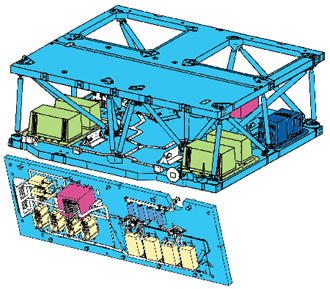![]()
The payload telemetry subsystem:
- Compresses video data generated by the HRG and HRS instruments.
- Formats data and inserts auxiliary data to assist image processing on the ground.
- Stores data in a high-capacity solid-state memory.
- Downlinks image data to stations directly or from memory via the X-band link.

Payload telemetry bay
Data compression
Each compressor receives image data from the HRG
and HRS instruments. An algorithm compresses the video streams on the basis
of the parameters defined for each imaging mode.
This algorithm is designed to be effective at a compression ratio of 2.28
to 2.8, depending on the imaging mode.
Data formatting
The formatting, encryption and routing systems retrieve the compressed video streams, which they then:
- Format, inserting auxiliary data to assist image processing on the ground.
- Route:
- to the RF transmitters for direct downlinking
- or to the solid-state memory for storage and transmission at a later time.
Data storage
The solid-state memory stores images acquired by
the HRG and HRS instruments and reads them out when the satellite passes within
view of a ground receiving station. Advances in microelectronic component
miniaturization have made it possible to equip SPOT 5 exclusively with a solid-state
memory and dispense with magnetic tape recorders.
This memory has no moving parts and therefore offers many advantages over
magnetic recorders, simplifying operation and ground control and improving
reliability. A 9-Gbit solid-state memory was used experimentally on the SPOT
4 satellite to back up the magnetic recorders.
The new solid-state memory on SPOT 5 provides an end-of-life capacity of 90
Gbits. It is made up of 16-Mbit DRAM chips supplied by IBM.
The onboard memory can store 550 images, compared to 400 on SPOT 4. Although the magnetic recorders provided more capacity (120 Gbits), the file management system allocates available storage capacity more efficiently. Image files in memory can be read out when required and downlinked to a receiving station to meet user requests, regardless of the order in which they are stored.
Image transmission
This subassembly downlinks acquired data to ground.
The data stream modulates the signal of an X-band transmitter, which amplifies the signal and sends it directly to a ground station from the satellite's omnidirectional antenna.
The data transmission rate, at 2x50 Mbps, is twice as fast as on previous SPOT satellites. Quadrature phase-shift keying (QPSK) is used to modulate the signal.
The image transmission subassembly consists of:
- Two QPSK modulators.
- Two X-band solid-state power amplifiers (SSPAs) capable of delivering 20 watts. (Upgraded from the travelling-wave-tube amplifiers on all previous SPOT satellites).
- An output multiplexer (OMUX) filter that filters and combines signals before directing them to the antenna.
- An increased-bandwidth antenna.
Operating modes
Depending on the payload operating mode, the payload telemetry subsystem processes one to five data strips acquired by the HRG and HRS instruments. A maximum of two strips can be downlinked directly to a ground station. The solid-state memory can record a maximum of three strips simultaneously for downlinking to a station at a later time.
Image processing capacity has been greatly increased (from two channels on SPOT 4 to five maximum on SPOT 5) and flexibility enhanced, since processing channels are managed independently of one another. The two compression and formatting systems are not backed up, but the payload telemetry subsystem can still handle a maximum of three data strips at a time if either system fails.
![]() Payload
telemetry block diagram
Payload
telemetry block diagram
More